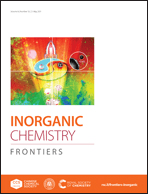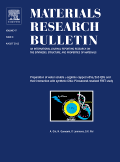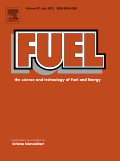
Carbon Letters
Scope & Guideline
Advancing Knowledge in Carbon Applications.
Introduction
Aims and Scopes
- Synthesis and Characterization of Carbon Materials:
The journal extensively covers innovative methods for synthesizing carbon materials such as graphene, carbon nanotubes, and activated carbon, along with their structural and electrochemical characterization. - Applications in Energy Storage and Conversion:
Research on carbon materials for energy applications, including their use as electrodes in batteries and supercapacitors, is a core focus area, highlighting advancements in lithium-ion and sodium-ion batteries. - Environmental Remediation:
Papers discussing the use of carbon materials for pollutant removal and environmental applications, including wastewater treatment and carbon capture, are prominently featured. - Biomedical Applications:
The journal includes studies on carbon nanomaterials in drug delivery, biosensing, and therapeutic uses, emphasizing their potential in healthcare. - Catalysis and Electrocatalysis:
Research on carbon-based catalysts for various chemical reactions, including oxygen reduction and nitrogen fixation, is a significant aspect of the journal's scope. - Nanocomposites and Hybrid Materials:
Studies on the development of hybrid materials incorporating carbon with other components to enhance properties for various applications are an essential part of the journal.
Trending and Emerging
- Green and Sustainable Synthesis:
There is a noticeable trend towards environmentally friendly synthesis methods for carbon materials, such as using biomass and waste products, which aligns with global sustainability goals. - Advanced Energy Storage Solutions:
Research focusing on high-performance energy storage solutions, including flexible supercapacitors and innovative battery technologies utilizing carbon materials, is increasingly prominent. - Carbon Nanomaterials in Biomedical Applications:
The application of carbon nanomaterials in drug delivery systems, biosensors, and imaging techniques is rapidly emerging as a significant area of interest. - Multifunctional Carbon Composites:
Studies on multifunctional composites that incorporate carbon materials for enhanced properties, such as thermal and electrical conductivity, are on the rise. - Nanostructured Carbon for Environmental Applications:
There is a growing focus on the use of nanostructured carbon materials for efficient environmental remediation, including pollutant adsorption and degradation. - Electrocatalysis for Renewable Energy:
Research on carbon-based electrocatalysts for renewable energy applications, particularly in hydrogen production and CO2 reduction, is gaining momentum.
Declining or Waning
- Traditional Carbon Applications:
Research focusing solely on traditional applications of carbon materials, such as in construction or basic filtration, has seen a reduction, as the field shifts towards more advanced and multifunctional applications. - Basic Graphene Studies:
Papers that address fundamental aspects of graphene without specific applications or innovations are less common, indicating a shift toward applied research. - Low-Impact Carbon Materials:
Research on low-impact or less innovative carbon materials, such as basic activated carbons without novel modifications or enhancements, is declining as more sophisticated materials gain attention. - Single-Use Carbon Products:
The focus has shifted away from single-use applications of carbon materials, reflecting a broader trend towards sustainability and recycling in material science.
Similar Journals

Carbon Trends
Illuminating the Path of Carbon InnovationsCarbon Trends is a cutting-edge, openly accessible journal published by ELSEVIER, dedicated to advancing research and discussion in the domains of Chemistry, Materials Chemistry, and Materials Science. Established in 2020, this journal has quickly become a pivotal platform for scientists and researchers to share innovative findings related to carbon materials and their applications. With a solid impact factor and a ranking in the second quartile (Q2) across multiple subject categories, including a percentile standing in the top two-thirds of global publications, Carbon Trends plays an essential role in shaping the future of materials science. The journal’s open access model ensures that valuable research is accessible to a broad audience, facilitating collaboration and knowledge dissemination. Researchers, professionals, and students alike will benefit from the insights and trends published within its pages, guiding them in the rapidly evolving field of carbon sciences.

Inorganic Chemistry Frontiers
Advancing the Boundaries of Inorganic ChemistryInorganic Chemistry Frontiers, published by the esteemed Royal Society of Chemistry, stands at the forefront of advancements in the field of inorganic chemistry, boasting a prestigious Q1 ranking in its category as of 2023 and an impressive Scopus Rank of #3 out of 79, placing it in the 96th percentile. Since its inception in 2014, this journal has provided a robust platform for high-quality research that spans the diverse and rapidly evolving areas of inorganic chemistry. As an open-access journal, it ensures that the findings presented are readily accessible to researchers, educators, and practitioners globally, fostering an inclusive environment for the dissemination of knowledge. With its rigorous peer-review process, Inorganic Chemistry Frontiers aims to facilitate interdisciplinary dialogue and innovation, making it an essential resource for anyone dedicated to exploring the myriad applications and theoretical advancements within inorganic chemistry.

International Journal of Electrochemical Science
Bridging theory and practice in electrochemical science.International Journal of Electrochemical Science is a peer-reviewed journal dedicated to disseminating cutting-edge research in the field of electrochemistry. Published by Elsevier in Serbia, this journal serves as a vital platform for scientists and researchers to explore innovative electrochemical techniques, processes, and applications. With an ISSN of 1452-3981, it has been a respected source of scholarly articles since its inception in 2006 and continues to bridge the gap between theoretical advancements and practical implementations up until 2024. Notably, it holds a Q4 quartile ranking in the field of electrochemistry and ranks 41 out of 60 in the Scopus database, situating it within the 32nd percentile among its peers. The journal champions open academic discourse, contributing significantly to the advancement of knowledge in electrochemical sciences, making it an essential resource for researchers, professionals, and students alike who are striving towards new discoveries and innovations.

JOURNAL OF CLUSTER SCIENCE
Innovating Insights Across Chemistry and PhysicsJOURNAL OF CLUSTER SCIENCE, published by SPRINGER/PLENUM PUBLISHERS, is a prominent and influential journal in the fields of Biochemistry, Chemistry, Condensed Matter Physics, and Materials Science. With an ISSN of 1040-7278 and E-ISSN of 1572-8862, this journal has been contributing to scientific discourse since its inception in 1990 and continues to publish cutting-edge research through 2024. It holds a respectable position in the academic landscape with its category quartiles indicating a Q3 ranking in Biochemistry and Q2 rankings in Chemistry, Condensed Matter Physics, and Materials Science as of 2023. The journal's noteworthy Scopus rankings further underscore its relevance, particularly a rank of #82 in Condensed Matter Physics, showcasing its impact and the quality of research disseminated. Although it does not currently offer open access options, it remains a key resource for researchers, professionals, and students who are invested in understanding the complexities of cluster science and its interdisciplinary applications.

Catalysts
Pioneering Discoveries in Heterogeneous and Homogeneous CatalysisCatalysts is a leading academic journal in the field of catalysis, published by MDPI since 2011 and well-regarded for its commitment to open access publishing. Based in Switzerland, this journal delivers innovative research and reviews that span various aspects of catalysis, from heterogeneous and homogeneous catalysis to the development of novel catalytic systems. With a commendable impact factor and a notable Q2 ranking in both Catalysis and Physical and Theoretical Chemistry categories, Catalysts plays a critical role in advancing the scientific discourse in these fields. The open-access model ensures that all research articles are readily accessible to researchers and professionals worldwide, fostering collaboration and accessibility to high-quality scientific literature. As the journal continues to publish cutting-edge studies up to its convergence in 2024, it remains an essential resource for anyone involved in catalysis research, from seasoned professionals to emerging scholars.

C-Journal of Carbon Research
Leading the Charge in Carbon Innovations and Environmental SolutionsC-Journal of Carbon Research is an innovative and dynamic journal published by MDPI, situated in the picturesque city of Basel, Switzerland. Launched in 2015 and operating under an Open Access model, the journal aims to promote the dissemination of high-quality research related to carbon science, environmental sustainability, and renewable resources. With a current impact factor reflecting its growing influence in the field, the journal's standing is bolstered by its Scopus ranking, placing it in the 37th percentile in the Environmental Science category. It offers a platform for researchers, professionals, and students alike to engage with cutting-edge studies, reviews, and discussions that contribute to environmental science advancements. As the journal continues its convergence journey from 2022 to 2024, it remains committed to fostering scholarly exchange and interdisciplinary collaboration on pressing carbon-related challenges.

MATERIALS RESEARCH BULLETIN
Exploring the frontiers of materials science and engineering.MATERIALS RESEARCH BULLETIN is a prestigious journal published by Pergamon-Elsevier Science Ltd, dedicated to advancing the field of materials science and engineering. Since its inception in 1966, the journal has served as a platform for high-impact research, particularly in areas such as condensed matter physics, mechanical engineering, and materials mechanics. With an impressive Q1 ranking in multiple categories, including Condensed Matter Physics and Materials Science, MATERIALS RESEARCH BULLETIN stands out as a leading resource in its domain, aiming to disseminate innovative research findings and methodologies that address fundamental and applied aspects of materials. The journal’s rigorous peer-review process ensures the publication of high-quality articles, making it an essential resource for researchers, professionals, and students alike. With its ongoing commitment to fostering scientific discourse and collaboration, MATERIALS RESEARCH BULLETIN remains at the forefront of materials research, contributing significantly to the global scientific community.

Boletin del grupo espanol del carbon
Pioneering Research in Carbon Applications and SustainabilityBoletin del Grupo Español del Carbon, a pivotal journal in the field of carbon science, is published by the Grupo Español Carbon and serves as a significant platform for disseminating research related to carbon materials, their applications, and advancements in carbon technology. With an ISSN of 2172-6094, this journal aims to bridge the gap between academia and industry by featuring original research articles, reviews, and noteworthy contributions from specialists in the sector. Though currently not designated as Open Access, the journal's commitment to quality ensures that the articles are available through various academic databases, enhancing accessibility for researchers, professionals, and students alike. Located in Zaragoza, Spain, at the prestigious Instituto Carboquímica, the journal endorses rigorous peer review and strives to foster international collaboration within the carbon research community. By maintaining high academic standards, Boletin del Grupo Español del Carbon aspires to impact the fields of materials science and environmental sustainability significantly.

Fuel
Pioneering Insights in Chemical and Power TechnologiesFuel is a premier international journal published by Elsevier Science Ltd, showcasing critical advancements and insights in the fields of chemical engineering, energy engineering, power technology, and organic chemistry. With a significant history dating back to 1922 and continuous publication from 1970 to 2025, Fuel holds an impressive position in the academic community, reflected in its top-tier rankings—Q1 in multiple categories including Fuel Technology and Chemical Engineering for the year 2023. This journal is dedicated to exploring innovative research and application of fuel technologies, driving forward the dialogue on sustainable energy solutions. Researchers and professionals alike will find Fuel to be an essential resource, providing access to high-impact articles that contribute to advancements in methodologies and applications, while navigating the complexities of global energy challenges.

Science China-Chemistry
Bridging Knowledge Gaps in Chemistry WorldwideScience China-Chemistry, published by SCIENCE PRESS, stands as a leading journal in the field of chemistry, specifically recognized for its contributions in miscellaneous chemistry domains. With an impressive Q1 categorization in the 2023 quartiles and ranking at #35/408 in general chemistry by Scopus, this journal places itself within the top 91st percentile, showcasing its significant impact in the discipline. The journal, based in Beijing, China, provides a platform for innovative research, reviews, and insights that cater to an international audience of researchers, professionals, and students dedicated to advancing chemical science. As an open-access journal, it ensures widespread dissemination of knowledge, making cutting-edge research accessible to all. With converged years from 2010 to 2024, the journal continues to be a vital resource for those engaged with the latest developments in chemistry.